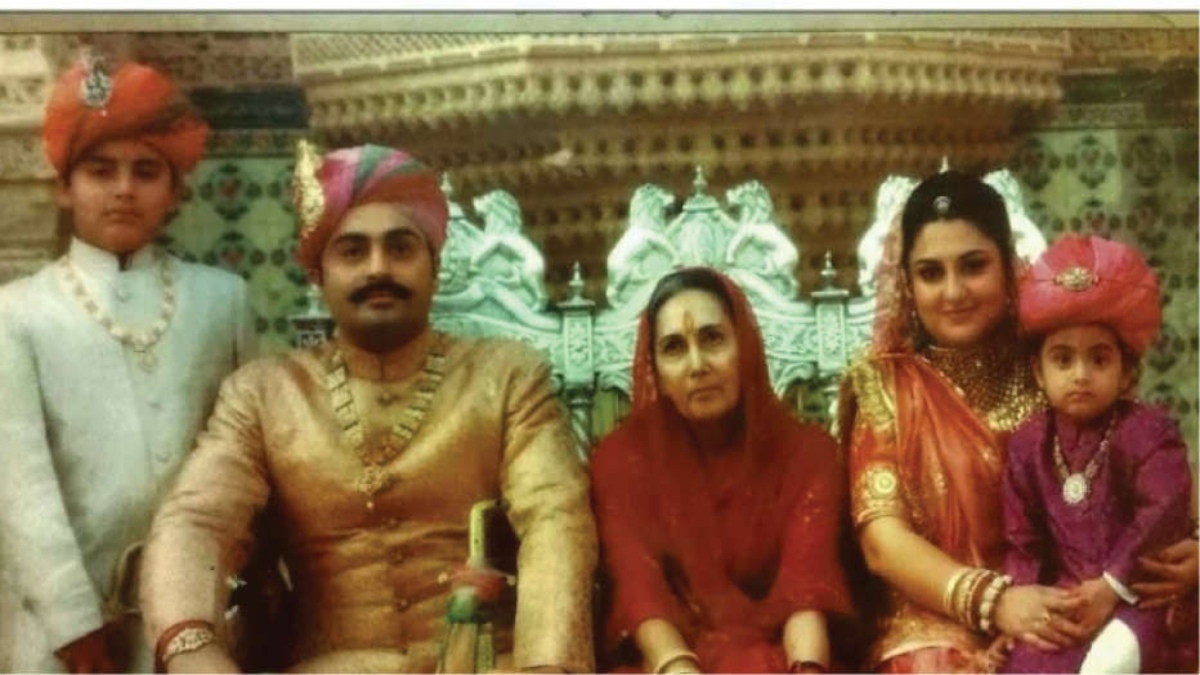


The December of 2020 brought a pall of gloom over the city of Jaisalmer with all the flags flying half-mast to mourn the death of its erstwhile ruler Maharawal Brij Raj Singh Bhati, who succumbed to a failed liver at the early age of 52. A dynamic yet introverted leader, he passed away at Medanta, surrounded by his two sons, Chaitanya Raj and Janmajayee, and wife, Raseshwari Kumari.
Half of all the royal families of India joined the family in grief, given the familial ties that the Jaisalmer royals have with so many ruling dynasties. His wife Raseshwari, hailing from the Rana family of Nepal, has her sisters married in Nabha and Gondol. The princesses of Jaisalmer are now the bahus of Kasmanda, Mayurbhanj, Sailana and Sahaspur Belari. Dr Karan Singh’s late wife was the late ruler’s aunt, and his nieces and nephews got married to the scions of Kangra, Jhabua and Mysore.


 Maharawal Brij Raj Singh. (Below right) Jaisalmer royal family.
Maharawal Brij Raj Singh. (Below right) Jaisalmer royal family.
It is cause for little wonder then that the Dastur ceremony (a coronation in the past) of his son, Maharwal Chaitanya Raaj Singh Bhati, personified the phrase “the king is dead, long live the king”. As chants from a hall full of purohits filled the air, Chaitanya, all of 27, took the seat of power to run the various enterprises helmed by his father. Shares his aunt, Sushma Kumari, “Chaitanya had our heart with the poise and grace he showed right through this sad and grueling ceremony, his young widowed mother by his and his brother, Janamajayee’s side.” Added Shailaja, a cousin, “The women of Jaisalmer showed great fortitude. Our grandmother, who has now lost both her sons, and the Maharani, rendered alone at such a young age, were symbols of grace.”
The Maharajas of Jaisalmer trace their lineage back to Jaitsimha, a ruler of a Bhati yadav clan during the 9th century. With him the title of “Rawal” commenced. “Rawal” means “of the royal house”. In 1156, Rawal Jaisal established his new capital in the form of a mud fort and named it Jaisalmer after himself. According to most historians, the Sikh Jats of Majha and Malwa Doaba and the rulers of Kapurthala state in Doaba in Punjab trace their direct lineage to Jaisalmer royal families over the centuries.
The Jaisalmer region was pat in the midst of the Silk Route, the camel caravan trade route which connected northern India and central Asia with the ports of Gujarat on the Arabian Sea coast of India and went on to Persia, Arabia and Egypt. Jaisalmer’s location made it an ideal staging post for imposing taxes on this trade. These taxes brought in a sense of great prosperity and flourish to this state, with not just the rulers, but also the Patwas who collected tax, benefitting from the Silk Route and turning their homes into majestic palaces and havelis carved out of the gold-hued sandstone, an indigenous material.
As trade moved to the sea and Bombay opened up as a port of trade, Jaisalmer lost its richness and prosperity. Ravaged further by famines and droughts, the city got its glory back only a few decades back when the mystical French travellers discovered the beauty of Jaisalmer – its sand dunes, lyrical by-lanes and splendidly carved havelis – placing it on the international tourism map.
This is the glory that the very young Maharwal has pledged to keep alive. Chaitanya Raj, an alumnus of SOAS, England, is first and foremost a philanthropist at heart. He has moved home to the family palace in Jaisalmer to support the locals with hemp farming, helping them create merchandise out of the produce. He and his mother are working hard to bring back tourism to this distant land and the glory of Jaisalmer as a center of reform, progress, patronage and culture. An example of this initiative is the Gyaan Center.
A revolution that had been quietly brewing for the last few years, Gyaan Center is a project of the Citta Foundation, spearheaded by American artist Michael Daube. A marvelous piece of architecture designed by New York-based architect Diana Kellogg and built around a stone structured palace donated by the Jaisalmer royal family, the center houses not just The Rajkumari Ratnavati School for girls but also a women’s cooperative that aims to empower the women of the region through craft employment and enhance gender parity in the region. A project wholly supported by Chaitanya and Raseshwari, who even donated the land it is built on, Gyaan Center by Citta Foundation is an architectural marvel. Its oval form is meant to reflect the curvilinear shapes of the local forts and the universal symbols of female strength.
Recognising the support of the Bhatis, Michael applauds the family saying, “The royal family of Jaisalmer supported the plans for this project and offered the use of a magnificent stone palace in the desert, located only 15 km from Jaisalmer, to develop the school. The centre is a unique combination of tourism and the ability to have many artists and volunteers visit the site, meanwhile, supporting education and economic development in the region. This scenario is the perfect configuration for stability, self-sustainability and the growth of the project. Tourists can visit the renovated site, pay entrance fees to sustain the school, purchase items from the women, who now have a venue to learn and create international standard crafts based on their local skills.”